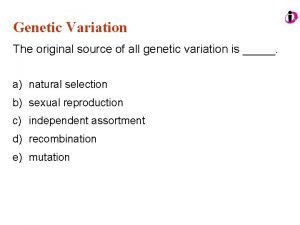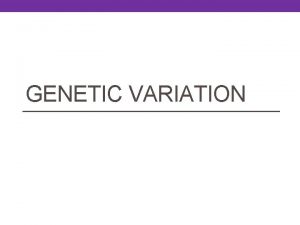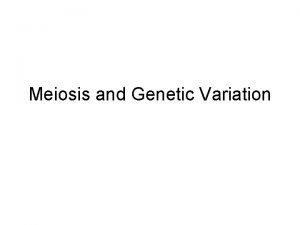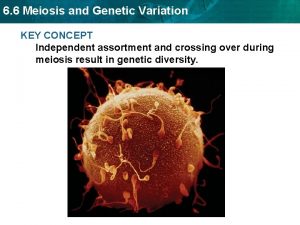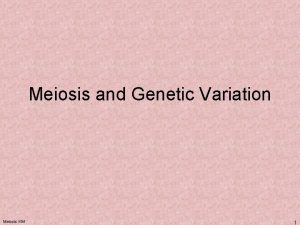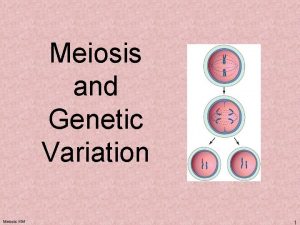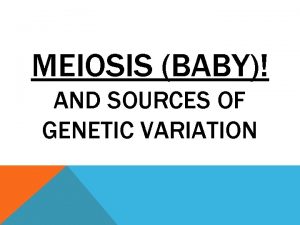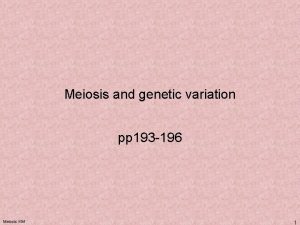6 6 Meiosis and Genetic Variation KEY CONCEPT








- Slides: 8

6. 6 Meiosis and Genetic Variation KEY CONCEPT Independent assortment and crossing over during meiosis result in genetic diversity.

6. 6 Meiosis and Genetic Variation Sexual reproduction creates unique combinations of genes. Sexual reproduction creates unique combination of genes and therefore increases genetic variation. There are 3 main ways sexual reproduction leads to increased genetic variation: – 1. independent assortment of chromosomes in meiosis - Meaning each chromosome lines up on the equator independently of other chromosomes. – 2. random fertilization of gametes example: in humans, a gamete can form with 223 (about 8 million) different combinations. During fertilization the total possible combinations are 223 x 223 , or 70 trillion, different combinations of chromosomes. • Unique traits may give a reproductive advantage to some organisms. Fig. 6. 1 –This image shows only a small sample of the great genetic potential for variety in the human population.

6. 6 Meiosis and Genetic Variation Crossing over during meiosis increases genetic diversity. • 3. Crossing over is the exchange of chromosome segments between homologous chromosomes. – occurs during prophase I of meiosis I – results in new combinations of genes – The farther apart two genes are located on a chromosome, the more likely they are to be separated by crossing over.

6. 6 Meiosis and Genetic Variation Summary of sources of genetic variation in eukaryotes: • 1. Independent assortment of chromosomes during of meiosis. • 2. Random fertilization. • 3. Crossing over of homologous chromosomes during prophase I of meiosis. Calculate: Fruit fly gametes each have 4 chromosomes, representing 24, or 16, possible chromosome combinations. How many chromosome combinations could result from fertilization between a fruit fly egg and a sperm cell?

6. 6 Meiosis and Genetic Variation Ch 5. 4 – Asexual Reproduction • Asexual reproduction is the creation of offspring from a single parent. These offspring are genetically identical to the parent. – Binary fission produces two daughter cells genetically identical to the parent cell. - Binary fission occurs in prokaryotes and is similar to mitosis that occurs in eukaryotes. In order for prokaryotes to increase their genetic diversity, they must undergo a process called conjugation. Fig 4. 1 –this image shows 3 individual bacteria, each at a different stage of binary fission. parent cell DNA duplicates cell begins to divide daughter cells

6. 6 Meiosis and Genetic Variation Ch 5. 4 Asexual Reproduction. • Budding forms a new organism from a small projection growing on the surface of the parent. This is a type of asexual reproduction in simple eukaryotic organisms. Synthesis: How might the asexual reproduction of genetically identical plants be useful to humans? How could it prove harmful to our food supply? Hydra bud Yeast Fig 4. 3 –budding occurs in simple fungi, plants and animals.

6. 6 Meiosis and Genetic Variation Ch 5. 4 Asexual Reproduction • Fragmentation is the splitting of the parent into pieces that each grow into a new organism. Examples: Flat worms and sea stars. • Vegetative reproduction forms a new plant from the modification of a stem or underground structure on the parent plant. Examples: strawberries and potatoes https: //www. elevise. co. uk/uploads/9/8/0/2/980215 60/screen-shot-2018 -03 -24 -at-11 -27 -40_orig. png

6. 6 Meiosis and Genetic Variation Ch 5. 4 –Advantages and Disadvantages of Asexual Reproduction • Environment determines what form of reproduction is most advantageous. – 1. Asexual reproduction is an advantage in consistently favorable conditions. If conditions change, it could become a disadvantage to reproduce asexually. – 2. Asexual reproduction does not involve attracting a mate. – 3. Asexual reproduction is a disadvantage when it comes to genetic variation. – 4. Asexual reproduction allows for rapid growth under ideal conditions. Fig 4. 2 –one bacterium can result in a total of 1024 cells after only 10 rounds of binary fission.
 Concept mapping chapter 10 meiosis 1 and meiosis 2
Concept mapping chapter 10 meiosis 1 and meiosis 2 Chapter 10 section 1 meiosis
Chapter 10 section 1 meiosis Chapter 10 meiosis 1 and meiosis 2 answer key
Chapter 10 meiosis 1 and meiosis 2 answer key Genetic drift in small populations
Genetic drift in small populations Genetic programming vs genetic algorithm
Genetic programming vs genetic algorithm Genetic programming vs genetic algorithm
Genetic programming vs genetic algorithm A gene pool consists of
A gene pool consists of Genetic drift vs genetic flow
Genetic drift vs genetic flow The original source of all genetic variation is
The original source of all genetic variation is








